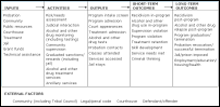Drug Court Performance Measures and Program Evaluation

Adult Drug Court Program Logic Model
Larger image and text description.
NIJ has developed a logic model for adult drug court programs that court administrators and their partners who want to examine the performance of their drug courts may find useful. The logic model can help clarify the best way to use resources and what long- and short-term outcomes drug court teams should consider measuring.
The logic model has six components:
- Inputs — financial, staff, equipment and other resources invested to support the program.
- Activities — structured services intended to deliver what is necessary to achieve objectives.
- Outputs — observable and measurable events resulting from program implementation.
- Short-term outcomes — immediate changes realized especially during program participation.
- Long-term outcomes — changes realized after program participation.
- External factors — conditions outside the program that affect implementation and outcomes.
Performance Measures
Using a logic model, the components can be tied to program objectives, as in these performance measures:
- Increase percentage of drug court participants who reduce substance use while in the program.
- Reduce percentage of drug court participants who reoffend while in the program.
- Increase percentage of drug court participants who graduate from the program.
- Increase total number of drug court graduates.
- Reduce percent of drug court participants who reoffend within one year after program completion.
Program Evaluation
The logic model also can guide evaluations of drug court programs:
- A process evaluation documents a program's actual caseflow, service delivery and resources in relation to its planned target population, policies and procedures over time.
- An outcome evaluation measures the program's influence on graduation, criminal recidivism and relapse among cohorts of participants.
- An impact evaluation gauges the effect of the intervention on the target population, if information is available on comparable defendants or offenders outside the program.
- Cost-efficiency analysis indicates what impact the program intervention has on public resource expenditures, and whether program investment yields savings over the status quo or some alternative.


